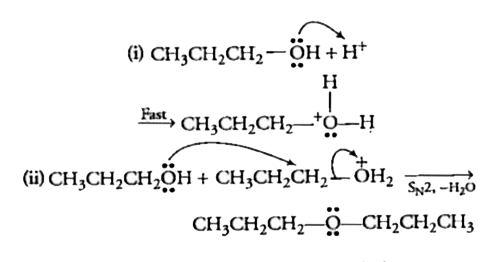Preparation of ethers by acid - catalysed dehydration of secondary and tertiary alcohols is not a suitable method. Give reason. Solution in Odia
Acid catalysed dehydration of 1∘ alcohols to ethers occurs by SN2 reaction involving nucleophilic attack by the alcohol molecule on the protonated alcohol molecule.

Under these conditions, 2∘ and 3∘ alcohols, however give alkenes rather than ethers. The reason is that due to steric hindrace, nucleophilic attack by the alcohol molecule on the protonated alcohol molecule does not occur. Instead protonated 2∘ and 3∘ alcohols lose a water molecule to form stable 2∘ and 3∘ carbocations. These carbocations prefer to lose a proton to form alkenes rather than undergoing nucleophilic attack by alcohol molecule to form ethers.

Topper's Solved these Questions
- ETHERS BOOK - ARIHANT PUBLICATIONCHAPTER - ETHERS EXERCISE - ODISHA BUREAU.S TEXTBOOK SOLUTIONS (A) Multiple Choice Type Questions
12 Videos
- ETHERS BOOK - ARIHANT PUBLICATIONCHAPTER - ETHERS EXERCISE - ODISHA BUREAU.S TEXTBOOK SOLUTIONS (B) Fill in the Blanks
8 Videos
- ETHERS BOOK - ARIHANT PUBLICATIONCHAPTER - ETHERS EXERCISE - QUESTIONS FOR PRACTICE (3 MARK)
11 Videos
- ELEMENTS : NITROGEN FAMILYBOOK - ARIHANT PUBLICATIONCHAPTER - ELEMENTS : NITROGEN FAMILYEXERCISE - CHAPTER PRACTICE ( Long Answer Type Questions )
11 Videos
- EXAMINATION PAPER 2018BOOK - ARIHANT PUBLICATIONCHAPTER - EXAMINATION PAPER 2018EXERCISE - GROUP C
7 Videos
Similar Questions
Which of the following will exhibit highest boiling point ?
View SolutionEthers exhibit functional isomerism with . . . . . . . . . . .
View SolutionCompound A having molecular formula, C4H10O is found to be soluble in concentrated sulphuric acid. It does not react with sodium metal or potassium permanganate. On heating with excess of HI, it gives a single alkyl halide. Deduce the structure of compound A and explain all the reactions.
View SolutionWhat happens when PCl5 is heated?
View SolutionState and exlain Kohlarausch.s law of independent migration of ions .
The equivalent conductance of infinite dilution (A0) for sodium acetate , sodium chloride and hydrochloric acid are 78, 109 and 384 ohm−1cm2 g.
Calculate the A0 of acetic acid .
View SolutionPreparation of ethers by acid dehydration of secondary or tetiary alcohols is not a suitable method. Give reason.
View Solutionद्वितीयक अथवा तृतीयक ऐल्कोहॉलो के अम्लीय निर्जलन द्वारा ईथरों को बंनाने की विधि उपयुक्त नहीं है! कारण बताइए!
View Solutionद्वितीयक अथवा तृतीयक ऐल्कोहॉलों के आम्लीय निर्जलन द्वारा ईथरों को बनाने की विधि उपयुक्त नहीं है। कारण बताइए।
View Solutionद्वितीयक अथवा तृतीयक ऐल्कोहॉलों का अम्लीय निर्जलीकरण ईथरों के निर्माण की उपयुक्त विधि नहीं है। कारण स्पष्ट कीजिए।
View SolutionPreparation of ethers by acid dehydration of secondary or tertiary alcohols is not a suitable method. Give reason.
View Solutionद्वितीयक व तृतीयक ऐल्कोहॉल के अम्ल-निर्जलीकरण द्वारा ईथर का बनना एक उपयुक्त विधि नहीं है, कारण दीजिये |
View SolutionPreparation of ethers by acid dehydration of secondary or tetiary alcohols is not a suitable method. Give reason.
View SolutionPreparation of ethers by intermolecular dehydration of alcohols in the presence of an acid is not a suitable method for mixed ethers. Give reason.
View SolutionPreparation of ethers by acid dehydration of secondary or tertiary alcohols is not a suitable method. Give reason.
View SolutionPreparation of ethers by acid dehydration of secondary or tetiary alcohols is not a suitable method. Give reason.
View Solution